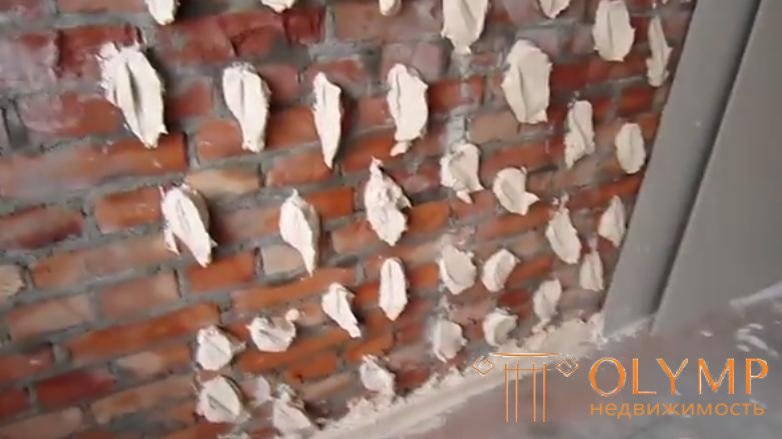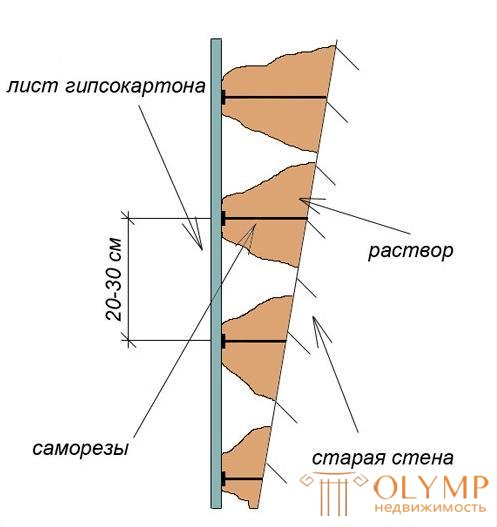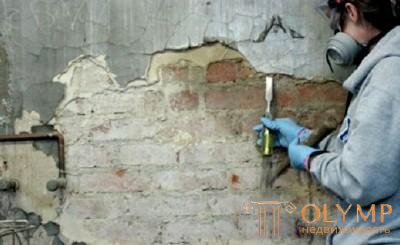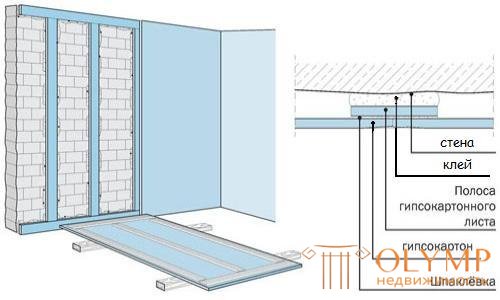
No one likes curved walls. To align them, there are many different methods, but the greatest effect can be achieved with the help of drywall. Many believe that this will require a crate assembled on a metal profile, but this is not always the case. It is possible to level the walls with drywall without frame. In this situation, time and space are saved significantly: you do not need to create a crate and it will not pick up part of the room's area.
Content:

For fixing plasterboard using adhesive composition instead of screws
Each type of finish has both advantages and disadvantages. What are the alignment of the walls of drywall pros and cons? The use of gypsum plasterboard for leveling walls without a frame has the following advantages:
However, the lack of a frame leads to the fact that there may be some inconvenience. Therefore, it is worthwhile to consider the disadvantages of the frameless method of wall leveling.

Self-tapping screws can act as beacons, helping to set the GKL exactly
As you can see, the alignment of the walls with drywall with their hands has more drawbacks than advantages. However, the eyes are usually closed to all the shortcomings due to the fact that it is easier to work independently with an adhesive solution than with profiles for the framework. Although it is very relative. Someone will be much easier to crate than working with a spatula and mortar.
In wet areas using moisture-resistant drywall. It has a greenish color. It is also used in rooms where there is increased dampness due to problems with heating in winter.
Before leveling the walls with drywall without a frame, they need to be carefully prepared. First of all, all old coverings are removed from the wall until a solid foundation is obtained. All old putty and loose plaster should be removed. Work should only be with a strong foundation. Also, the surface is cleaned from dirt, dust and grease. This is done to improve adhesion.
With the help of the rule and plummet determine how large is the difference of heights. It is necessary to identify how the curve is the wall, and where are its projections. After that, it will be clear what and where will be leveled. It is on the maximum projection that the entire surface will be leveled. Perhaps there are small protrusions that would cost to cut a chisel or an ax. The smaller the elevation difference, the cheaper all the work will be.

If the old plaster does not hold well, it must also be removed.
To know how to level a wall with a drywall without a profile, you need to find out how the working surface absorbs moisture. Depending on how much the wall absorbs moisture, select a special primer. Different primers may reduce the absorption of a liquid by the wall or not. For example, concrete and monolithic surfaces are coated with a primer like "Betonokontakt". For surfaces with high hygroscopicity, I use Tifengrund type primers.
For better adhesion, you can cover the back side of drywall sheets with the same primer that is applied to the wall.
Dry wall is treated with primer. The easiest way to do this is with a roller. Depending on the material chosen, it may be necessary to prime in two layers. On the packaging is always indicated such information, as well as how much the wall should dry out after such a procedure. Wall leveling with drywall without a profile is carried out on a dry surface, so you have to wait for the primer to dry.
Before the start of the assembly works of the State Forest Committee, it is recommended to stand a couple of days in the room where they will be used. You also need to calculate in advance how many sheets will be required. You can draw a simple mounting scheme on a piece of paper to calculate how many whole sheets will go away and how many sheets will be required for the remaining sections. But if the elevation difference is too large, then additional sheets of drywall may be required.
Wall leveling with drywall without frame can be carried out by several methods. They depend on what height difference you want to compensate. Consider the three main cases.

Adhesive should not be from the very edge, so as not to fall on the joints of sheets
Such a small drop suggests that the wall is almost flat, which means that it is very easy to align. Most often from a framework from a metalprofile refuse in such cases. For fixing plasterboard fit the most common plaster putty. It is sold in dry form, so it will need to be stirred with water until a thick pasty substance is obtained. So there is no need to buy a more expensive adhesive.
In principle, you can opt for acrylic putty, which is sold in finished form. It does not need to carry out batches and calculate the proportions of water needed.
Apply the composition with a spatula on the reverse side of the drywall. And the putty is applied in small rows along the perimeter and in the center. They are leveled on the sheet so that their thickness is the same. It is important to know how to properly level the walls with plasterboard under the tile. Due to the large load from the GCR ceramic tiles, the whole is processed by putty, and not just around the perimeter.
Now you can press the gypsum to the wall. Someone taps a rubber mallet, and someone presses the sheet by hand force. At this point, you should know where on the wall is the biggest bulge, and where is the biggest depression. The amount of putty and force clamping GKL to the wall will compensate for the difference up to 4 mm.

The solution can be applied directly to the wall.
Also putty can be put directly on the wall, but you need to know exactly how the sheet will go. Regardless of where the adhesive is applied, you need to work with a spatula. It helps to evenly distribute the putty on the surface.
Alignment of the walls with drywall to glue is carried out in the case when the height difference is 4-20 mm. Typically, Perflix or similar product is used. This method differs little from the previous version:
All further work is no different from those described earlier. Sheets of drywall should be fastened as tightly as possible to each other. The lowermost sheets can be installed on a peculiar support (trim GKL) so that they do not touch the floor. After a couple of days, the supports will need to be removed, and the gap will be covered with sealant.
If the height difference is no more than 4 cm, then it is still possible to level the walls with drywall without a frame with your own hands. If the surface falls more than 4 cm, then you should think about the frame.
Drywall strips are used to fill cavities on the surface. GCR is taken and cut into 10-centimeter strips along the length of the problem area. The strips are mounted vertically on the same adhesive in increments of 40-50 centimeters. So we will be able to block a significant difference in height, which is compensated by the drywall strip.

Such strips should be pretreated with primer on both sides.
These strips will serve as a kind of frame, to which sheets of drywall will be then attached according to the technology described earlier. Remember that these pieces of gypsum plasterboards should be firmly fixed, so you have to wait up to three days. Now you know how to level the walls with the help of drywall without using crates from metal profiles.
When the work has been completed and the wall has been leveled, one must wait until the used mixtures have completely dried. It will take 2-3 days. Then you should putty all joints. All places where gypsum from gypsum projects should be covered with putty or acrylic sealant. This is done so that moisture does not penetrate the sheet and it does not swell in the future.
Since the screws were not used, then they do not need to putty, which is a definite plus. How to proceed with a flat and smooth surface, everyone decides for himself. The choice should depend on the final finish to be used.
I would like to separately consider how to level the walls with drywall in a wooden house. Usually in this case, the walls are almost flat, so you can work on the first method. However, the tree has its own nuance. You can use less adhesive mass, and the sheets are additionally secured to the wood with screws. Someone recommends the use of nails, but you can take off and overdo it and drive them too hard, bending the drywall.
Self-tapping screws should be used carefully. They are driven flush with the gypsum, but the screw will first draw the gypsum plaster to the maximum, and then just “drown” in the sheet. Therefore, it is worth considering whether it is necessary to use screws in this case.
Also do not forget about special primers for wood with anti-fungal additives. The wooden base itself must be covered with a special waterproofing mixture before leveling, so as not to rot and mold.
Что бы оставить комментарий войдите
Комментарии (0)